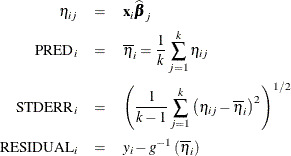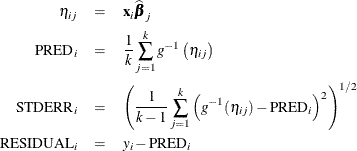The PLM Procedure
SCORE Statement
-
SCORE DATA=SAS-data-set <OUT=SAS-data-set><keyword<=name>> …<keyword<=name>> </ options>;
The SCORE statement applies the contents of the source item store to compute predicted values and other observation-wise statistics for a SAS data set.
You can specify the following syntax elements in the SCORE statement before the option slash (/):
Table 87.9: Keywords for Output Statistics
|
Keyword |
Description |
Expression |
Name |
|---|---|---|---|
|
PREDICTED |
Linear predictor |
|
Predicted |
|
STDERR |
Standard deviation of linear predictor |
|
StdErr |
|
RESIDUAL |
Residual |
|
Resid |
|
LCLM |
Lower confidence limit for the linear predictor |
LCLM |
|
|
UCLM |
Upper confidence limit for the linear predictor |
UCLM |
|
|
LCL |
Lower prediction limit for the linear predictor |
LCL |
|
|
UCL |
Upper prediction limit for the linear predictor |
UCL |
|
|
PZERO |
zero-inflation probability for zero-inflated models |
|
PZERO |
Prediction limits (LCL, UCL) are available only for statistical models that allow such limits, typically regression-type models for normally distributed data with an identity link function. Zero-inflation probability (PZERO) is available only for zero-inflated models. For details on how PROC PLM computes statistics for zero-inflated models, see Scoring Data Sets for Zero-Inflated Models.
You can specify the following options in the SCORE statement after a slash (/):













